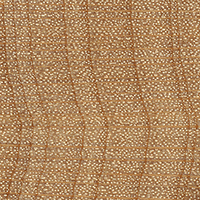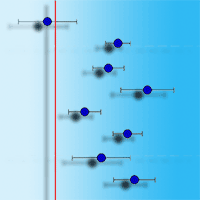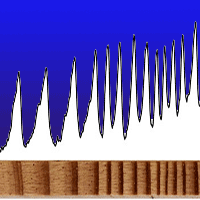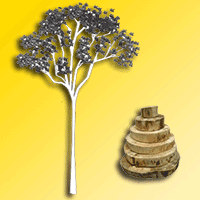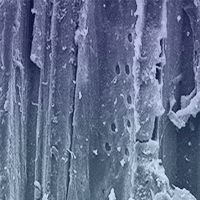
Contrasted growth response of hybrid larch (Larix × marschlinsii), jack pine (Pinus banksiana) and white spruce (Picea glauca) to wood ash application in northwestern Quebec, Canada
Nicolas Bélanger (1) , Gustavo Palma Ponce (2), Suzanne Brais (2)
iForest - Biogeosciences and Forestry, Volume 14, Issue 2, Pages 155-165 (2021)
doi: https://doi.org/10.3832/ifor3597-014
Published: Apr 06, 2021 - Copyright © 2021 SISEF
Research Articles
Abstract
The use of wood ash as a soil amendment in afforestation and reforestation efforts is increasing. While most studies suggest benefits or neutral results on tree growth and survival, a few studies indicate adverse effects. Hybrid larch, jack pine and white spruce were studied at three northwestern Quebec plantation sites after they received wood ash at two application rates. Soil chemical properties, foliar nutrients and seedling growth and mortality were monitored over a period of eight years. The response of soil to ash application was mostly observed in the forest floor and was more pronounced in year 3 than year 8, likely due to the acidifying nature of the boreal soils studied. Jack pine growth increased linearly with wood ash application rates, white spruce growth showed an inconsistent and delayed positive response under the higher application rate, and hybrid larch growth and survival were either increased or decreased under the lower application rate depending of site but decreased at all sites under the higher application rate. The divergence in growth response between tree species underlines a trade-off between species with rapid acquisition of resources (e.g., pine, larch) to species that use more conservative strategies and store nutrients in their tissues for longer periods (e.g., spruce). In the case of hybrid larch, it accumulated larger amounts of Mn in its needles under the higher application rate and thus, the high bioavailability of Mn appears to have been detrimental to its survival and growth. Its higher sensitivity to Mn addition from ash is likely due to its highly acquisitive (nutrients) nature compared to other coniferous species as well as the initial levels of available Mn levels in the soil. The contrasted growth responses reported here under similar growing conditions highlight the importance of identifying suitable species, sites and application rates to maximize the benefits of wood ash amendments for future tree plantations in the boreal forest.
Keywords
Wood Ash, Fertilization, Boreal Forest, Soil Properties, Foliar Nutrition, Tree Growth
Authors’ Info
Authors’ address
Département Science et Technologie, Université TÉLUQ, 5800, rue Saint-Denis, Bureau 1105, Montréal, Québec H2S 3L5 (Canada)
Suzanne Brais 0000-0002-8604-4447
Institut de Recherche sur les Forêts, Université du Québec en Abitibi -Témiscamingue, 445 Blv. Université, Rouyn-Noranda, Quebec J9X 5E4 (Canada)
Corresponding author
Paper Info
Citation
Bélanger N, Palma Ponce G, Brais S (2021). Contrasted growth response of hybrid larch (Larix × marschlinsii), jack pine (Pinus banksiana) and white spruce (Picea glauca) to wood ash application in northwestern Quebec, Canada. iForest 14: 155-165. - doi: 10.3832/ifor3597-014
Academic Editor
Gianluca Piovesan
Paper history
Received: Jul 21, 2020
Accepted: Jan 29, 2021
First online: Apr 06, 2021
Publication Date: Apr 30, 2021
Publication Time: 2.23 months
Copyright Information
© SISEF - The Italian Society of Silviculture and Forest Ecology 2021
Open Access
This article is distributed under the terms of the Creative Commons Attribution-Non Commercial 4.0 International (https://creativecommons.org/licenses/by-nc/4.0/), which permits unrestricted use, distribution, and reproduction in any medium, provided you give appropriate credit to the original author(s) and the source, provide a link to the Creative Commons license, and indicate if changes were made.
Web Metrics
Breakdown by View Type
Article Usage
Total Article Views: 35876
(from publication date up to now)
Breakdown by View Type
HTML Page Views: 29974
Abstract Page Views: 3269
PDF Downloads: 2076
Citation/Reference Downloads: 6
XML Downloads: 551
Web Metrics
Days since publication: 1732
Overall contacts: 35876
Avg. contacts per week: 145.00
Citation Metrics
Article Citations
Article citations are based on data periodically collected from the Clarivate Web of Science web site
(last update: Mar 2025)
Total number of cites (since 2021): 6
Average cites per year: 1.20
Publication Metrics
by Dimensions ©
Articles citing this article
List of the papers citing this article based on CrossRef Cited-by.
References
Determining nutrient availability in forest soils. In: “Soil Sampling and Methods of Analysis - 2nd edn” (Carter M, Gregorich EG eds). CRC Press, Boca Raton, FL, USA, pp. 317-330.
Gscholar
Guide de référence en fertilisation [Fertilization reference guide] (2nd edn). Centre de Référence en Agriculture et Agroalimentaire du Québec - CRAAQ, Québec, Canada, pp. 479. [in French]
Gscholar
The plant traits that drive ecosystems: evidence from three continents. Journal of Vegetation Science 15: 295-304.
CrossRef | Gscholar
Synthesis of current AshNet study designs and methods with recommendations towards a standardized protocol. Information Report GLC-X-22, Natural Resources Canada, Canadian Forest Service, Great Lakes Forestry Centre, Sault Ste. Marie, Canada, pp. 39.
Online | Gscholar
Short-term growth response of jack pine and spruce spp. to wood ash amendment across Canada. Global Change Biology - Bioenergy 12: 158-167.
CrossRef | Gscholar
Regulations and guidelines for use of wood ash as soil amendment in Canadian forests. Information Report GLC-X-17, Canadian Forest Service, Natural Resources Canada, Great Lakes Forestry Centre, Sault Ste. Marie, Canada, pp. 46.
Online | Gscholar
Guide sur le recyclage des matières résiduelles fertilisantes: critères de référence et normes réglementaires [Guide to recycling fertilizing residual materials: benchmarks and regulatory standards] (edn 2015). Gouvernement du Québec, Québec, Canada, pp. 216. [in French]
Gscholar
Marschner’s mineral nutrition of higher plants (3rd edn). Academic Press, London, UK, pp. 672.
Gscholar
Manual on soil sampling and methods of analysis (2nd edn). Canadian Society of Soil Science, Ottawa, Canada, pp. 179.
Gscholar
The state of Canada’s forests. Annual report 2018. Natural Resources Canada - NRC, Canadian Forest Service, Ottawa, Canada, pp. 76.
Gscholar
Zones de végétation et domaines bioclimatiques du Québec [Vegetation zones and bioclimatic domains of Quebec] (3rd edn). Ministère des Ressources Naturelles, de la Faune et des Parcs, Québec, Canada. [map - in French]
Gscholar
The effect of soil manganese on Japanese larch (Larix leptolepis Sieb. and Zucc.) seedlings in the greenhouse. In: Proceedings of the “12th Central Hardwood Forest Conference”. General Techical Report SRS-24, USDA Forest Service, Southern Research Station, Asheville, USA, pp. 293.
Online | Gscholar
Is hybrid larch the future of the northern forest? The Northern Logger 12: 10-16.
Gscholar
Mehlich 3 - Extractable elements. In: “Soil Sampling and Methods of Analysis - 2nd edn” (Carter MR, Gregorich EG, eds.). CRC Press, Boca Raton, FL, USA, pp. 81-88.
Gscholar


